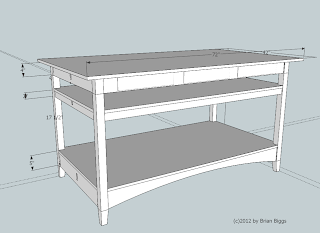Ah, summer -- vacations, lawn work, thunderstorms and power outages... all the good things in life. I've been focused on doing more work with hand tools, and when we had a major storm recently that took out power for several days, I thought to myself that I had the perfect opportunity to play with the tools. My shop is in the basement, in the back. Away from any windows. And without power, it's very, very dark. What I found out is that a good hand tool shop needs to have windows to allow for light. I did try to work under just a couple of flashlights - and wondered how our predecessors worked by candle light. Lines are very hard to see, shadows get in the way all the time, and frankly I couldn't do much more than just clean up an put stuff away.
All this reinforced my longer term plans for an out building that would include lots of windows - about 2' high, and at least 4' off the floor. I want to make sure that I get enough light in the building, but I don't want to have the low windows that are popular in houses that would have a work bench right up against it. I worry about stuff like a tool or board jumping off the bench and through the window.
All this reinforced my longer term plans for an out building that would include lots of windows - about 2' high, and at least 4' off the floor. I want to make sure that I get enough light in the building, but I don't want to have the low windows that are popular in houses that would have a work bench right up against it. I worry about stuff like a tool or board jumping off the bench and through the window.

.JPG)
.JPG)




